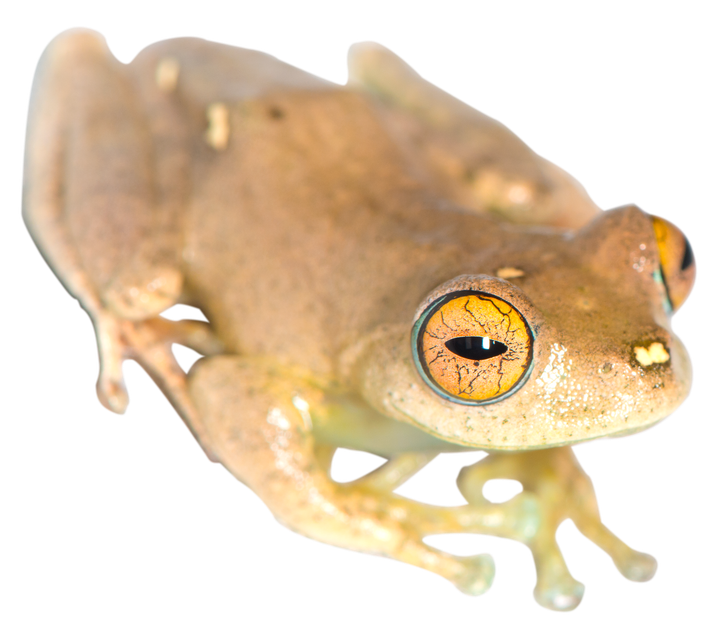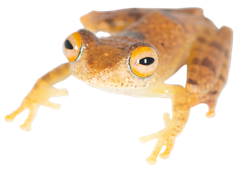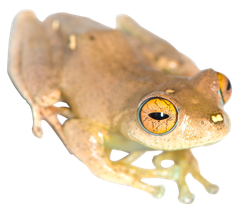Seven New Frog Species Discovered in Madagascar: Sounds Like Something from Star Trek
An international team of researchers have discovered seven new species of tree frogs that make otherworldly calls in the rainforests of Madagascar. Their strange, high-pitched whistling calls sound more like sound effects from the sci-fi series Star Trek. As a result, the researchers have named the new species after seven of the series' most iconic captains.

If you think all frogs croak, you’d be wrong. Seven newly discovered species from the tree frog genus Boophis, found across the rainforests of Madagascar, emit special bird-like whistling sounds in their communication with other frogs.
These whistling sounds reminded the research team, led by Professor Miguel Vences of the Technische Universität Braunschweig, Germany, of Star Trek, where similar whistle-like sound effects are frequently used.
“That’s why we named the frogs after Kirk, Picard, Sisko, Janeway, Archer, Burnham, and Pike—seven of the most iconic captains from the sci-fi series,” says Professor Vences.
“Not only do these frogs sound like sound-effects from Star Trek, but it seems also fitting that to find them, you often have to do quite a bit of trekking! A few species are found in places accessible to tourists, but to find several of these species, we had to undertake major expeditions to remote forest fragments and mountain peaks. There’s a real sense of scientific discovery and exploration here, which we think is in the spirit of Star Trek,” explains Assistant Professor Mark D. Scherz from the Natural History Museum of Denmark at the University of Copenhagen, who was senior author on the study.
To Drown Out the Sound of Water
The otherworldly calls of these frogs are known as "advertisement calls"—a type of self-promotion that, according to the researchers, may convey information about the male frog’s suitability as a mate to females. This particular group live along fast-flowing streams in the most mountainous regions of Madagascar—a loud background that may explain why the frogs call at such high pitches.
For fans of Star Trek, some of the frog calls might remind them of sounds from the so-called ‘boatswain whistle’ and a device called the ‘tricorder.’ To others, they might sound like a bird or an insect.
“If the frogs just croaked like our familiar European frogs, they might not be audible over the sound of rushing water from the rivers they live near. Their high-pitched trills and whistles stand out against all that noise,” explains Dr Jörn Köhler, Senior Curator of Vertebrate Zoology at the Hessisches Landesmuseum Darmstadt, Germany, who played a key role in analyzing the calls of the frogs.
“The appearance of the frogs has led to them being confused with similar species until now, but each species makes a distinctive series of these high-pitched whistles, that has allowed us to tell them apart from each other, and from other frogs,” he says.
The calls also lined up with the genetic analysis the team performed.
Vulnerable to Climate Change
Madagascar is renowned for its immense biodiversity, and research in its rainforests continues to uncover hidden species, making it a true paradise for frogs. Madagascar, an island roughly the size of France, is home to about 9% of all the world’s frog species.
“We’ve only scratched the surface of what Madagascar’s rainforests have to offer. Every time we go into the forest, we find new species, and just in terms of frogs, there are still several hundred species we haven’t yet described,” says Professor Andolalao Rakotoarison of the Université d’Itasy in Madagascar. Just in the last ten years, she and the rest of this team have described around 100 new species from the island.
The researchers behind the discovery hope that this new knowledge will strengthen conservation efforts in Madagascar’s rainforests. The species often live in close geographic proximity but at different altitudes and in different microhabitats. This division makes them particularly vulnerable to changes in climate or the environment.
Thus, the research team urges greater awareness around the conservation of Madagascar’s biodiversity to ensure that these unique species and their habitats are preserved for the future. But they also hope to continue exploring, to seek out new species in forests where no scientist has gone before.
Sound files of the frogs attached below.
Link to full media package: http://www.markscherz.com/publicfiles/StarTrekFrogs_MediaPackage.zip
Nøgleord
Kontakter
Mark D. Scherz
Natural History Museum of Denmark at the University of Copenhagen
+45 42 55 95 88
mark.scherz@gmail.com
Billeder
Vedhæftede filer
Følg pressemeddelelser fra Københavns Universitet
Skriv dig op her, og modtag pressemeddelelser på e-mail. Indtast din e-mail, klik på abonner, og følg instruktionerne i den udsendte e-mail.
Flere pressemeddelelser fra Københavns Universitet
Denmark Can Now Produce World-Class Chips21.8.2025 14:16:54 CEST | Press release
For the first time, Denmark is establishing production of microchip wafers at the leading standard. This makes Denmark a global player in chip production. The new “wafer factory,” which will be part of the University of Copenhagen, also gives a major advantage to Danish quantum researchers.
Nu kan Danmark producere chips i verdensklasse21.8.2025 13:56:05 CEST | Pressemeddelelse
For første gang etablerer Danmark produktion af mikrochip-wafers af den førende standard. Dermed bliver Danmark en global spiller i chipproduktionen. Den nye ”waferfabrik”, som bliver en del af Københavns Universitet, giver samtidig danske kvanteforskere en stor fordel.
Slædehundes DNA afslører skjult kapitel i Grønlands historie21.8.2025 06:00:00 CEST | Pressemeddelelse
Inuit ankom flere hundrede år tidligere til Grønland end hidtil antaget. Det viser en kortlægning af slædehundes gener, som forskere på blandt andet Københavns Universitet står bag.
Intergalactic experiment: Researchers hunt for mysterious dark matter particle with clever new trick15.8.2025 11:01:00 CEST | Press release
Physicists from the University of Copenhagen have begun using the gigantic magnetic fields of galaxy clusters to observe distant black holes in their search for an elusive particle that has stumped scientists for decades.
Intergalaktisk eksperiment: Forskere jagter mystisk mørkt stof-partikel med snedigt trick15.8.2025 11:01:00 CEST | Pressemeddelelse
Fysikere fra Københavns Universitet bruger gigantiske magnetfelter i galaksehobe til at observere sorte huller i jagten på en partikel, der har mystificeret forskere i årtier.
I vores nyhedsrum kan du læse alle vores pressemeddelelser, tilgå materiale i form af billeder og dokumenter samt finde vores kontaktoplysninger.
Besøg vores nyhedsrum

